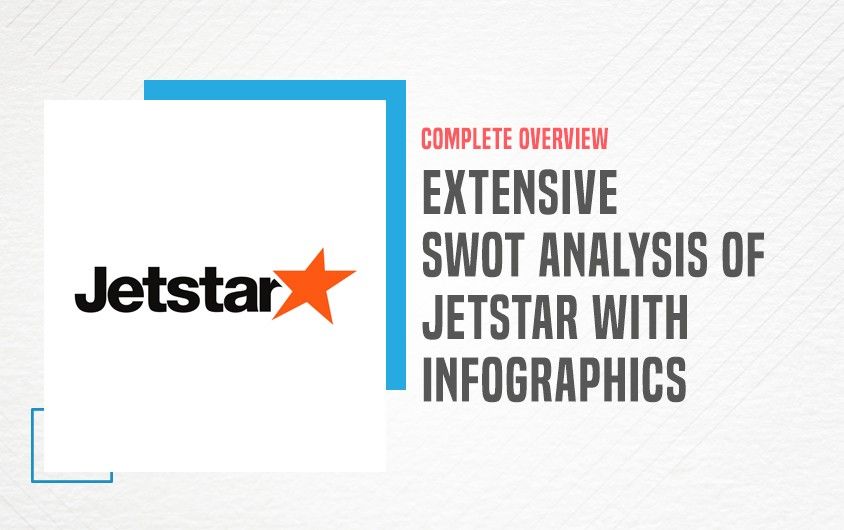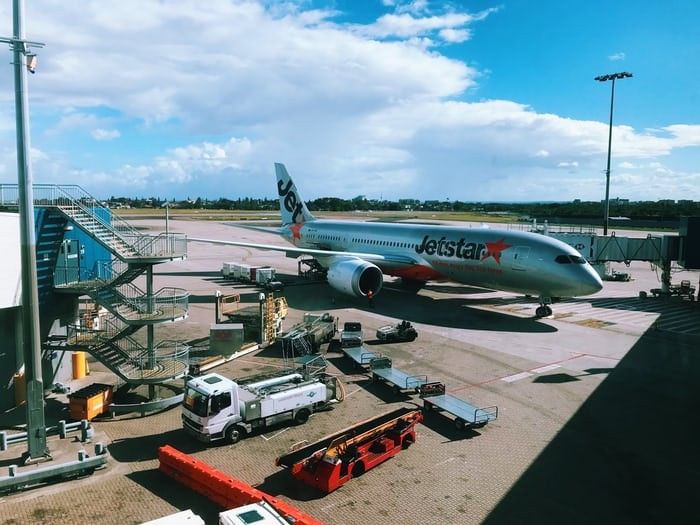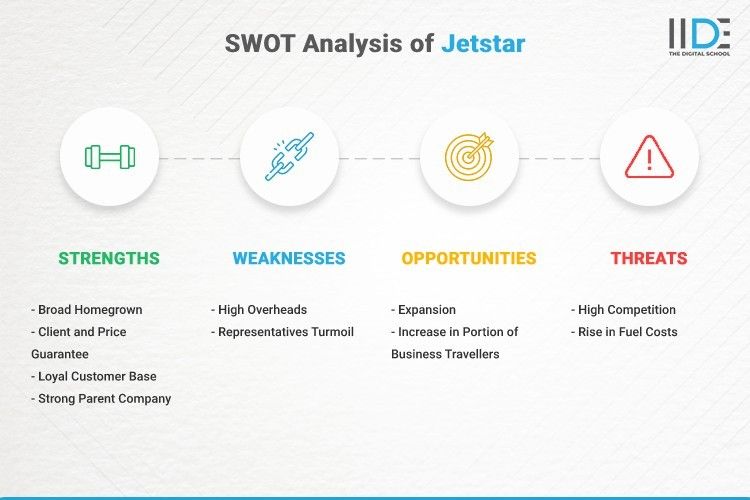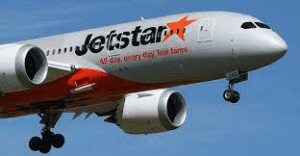Decode how AI is reshaping careers in 2026 with our Head of AI Programs in a LIVE online session. Register Now.

Updated on Aug 9, 2025
Share on:
Last time we saw the Marketing Strategies of SpiceJet, today let’s look at the SWOT analysis of Jetstar.
Jetstar is an Australian low-cost airline located in Melbourne and self-described as “value-focused”. Its headquarters are in Collingwood, Melbourne, Victoria, Australia. It was specially introduced by the Qantas group to target the low-cost market, people who are preferring affordable prices over premium and luxury services.
The company has accurately targeted its audience by using accurate marketing strategies for example the tagline of the brand – “All day, every day, low fares”.
Marketing and its digital aspect are very important for the growth of any business, especially after the pandemic. If you want to learn more about digital marketing, do check out Free Digital Marketing Masterclass by Karan Shah the founder and CEO of IIDE.
In this case study we will look at the SWOT analysis of Jetstar but before that let’s know more about the company.
About Jetstar
Jetstar Airways Ltd was established in the year 2003, It is a wholly-owned subsidiary of Qantas that was established in response to the challenge posed by Virgin Blue Airlines. Jetstar is a part of Qantas’ two-brand strategy, which includes Qantas Airways for premium full-service travel and Jetstar for low-cost travel. Jetstar transports 8.5 percent of all passengers entering and leaving Australia.
From its primary base at Melbourne Airport, the airline operates a large domestic network as well as regional and international services, employing a mixed fleet of Airbus A320 and Boeing 787 Dreamliners.

Qantas, through the Jetstar Group, also has stakes in sister airlines Jetstar Asia Airways and Jetstar Japan.
Jetstar’s main marketing strategy is to use Low-Cost Carriers (LCC) services, which were dispatched by its parent company (Qantas). Jetstar provides low-cost support to both domestic and international travelers. When compared to the high cost, the business can attract a larger share of the pie by offering minimal costs perks.
| Founder | Qantas |
|---|---|
| Year Founded | 2003 |
| Origin | Australia |
| No. of Employees | 7500 |
| Company Type | Public |
| Market Cap | NA |
| Annual Revenue | 3.636 Billion (2016) |
| Net Income/ Profit | 0.452 Billion (2016) |
Services Provided by Jetstar
Following are the services provided by Jetstar
- Domestics Flights
- International Flights
Competitors of Jetstar
Below are the top 5 competitors of Jetstar Airways:
- Air New Zealand
- Virgin Australia
- Tigerair Australia
- Viator
- HK Express
SWOT Analysis of Jetstar

SWOT analysis analyses the brand by its strengths, weaknesses, opportunities & threats. It is a proven management framework that enables a brand like Jetstar to benchmark its business & performance as compared to the competitors.
1. Strengths of Jetstar
Strengths describe what an organization excels at and what separates it from other organizations.
- Broad Homegrown and Provincial Presence – All Jetstar aircraft have a “buy on board” service whereby food items can be purchased on-board. Jetstar offers a two-stage service on all international routes of the Boeing 787.
- Client Guarantee and Price Guarantee Programme – In this service, catering service is provided in the aircraft, entertainment service available in the flight, and the facility of carrying up to 30 kg of luggage is provided.
- Loyal Customer Base – Jetstar has achieved a loyal customer base due to its affordable prices, people prefer the company as air travel is a luxury and they get it at low prices.

- Strong Parent Company – The airline was established by Qantas in 2003 as a low-cost domestic subsidiary. Jetstar has a strong brand image due to its powerful parent company providing the recognition.
2. Weaknesses of Jetstar
Weakness stops an organization from performing at its optimum level. These are the areas where the business needs to improve to remain competitive. Here are the shortcomings of Jetstar Airways.
- High Overheads – Shortcomings are that Carriers have a high “decay” rate contrasted with most different businesses. When a flight leaves the entryway, an unfilled seat is lost and non-income creating. The airplane is not costly but requires immense capital expenses.
- Representatives’ Turmoil – In 2019 Jetstar representatives in Australia including pilots, things overseers, and ground team picketed throughout the end of the week in interest for higher wages and better working conditions, which is not good for the image of the company.
3. Opportunities of Jetstar
Opportunities refer to the favorable external factors that could give an organization a competitive advantage. Opportunities in SWOT analysis are the external factors that the entity can capitalize on and use to its advantage.
Following are the Opportunities in Jetstar Airways SWOT Analysis :
- Expansion- The company can expand its services and increase the number of flights in many other regions and countries to cater to a larger audience, it is a great opportunity for it as the majority of the public prefers affordable air travel over any other way.
- Increase in Portion of Business Travellers – The company can focus on business travelers more both regional and international travelers as they are the most frequent travelers and can help the company raise its market share.
4. Threats of Jetstar
Threats include anything that can negatively affect the business from the outside, such as supply chain problems, Shifts in market requirements, and inner storage recruits. It’s vital to anticipate threats and to take action against them before you become a victim of them and your growth stalls.
- High Competition – Jetstar faces high competition from other low-cost airlines, providing services in its country and internationally.
- Rise in Fuel Costs – The USP of Jetstar is its low-cost services, which can suffer due to rising fuel prices and this can become a major threat for the company.


Learn Digital Marketing for FREE


Conclusion
We can say that Qantas has achieved its target to launch a low-cost yet effective airline by Jetstar. The company is doing well with its effective services and has gotten a loyal customer base due to its affordable prices. The brand name of Qantas has helped Jetstar a lot in creating its brand image and has already given it a strong base. The company needs to adapt to changes to have a competitive advantage because the airline industry is very volatile and some wrong decisions can lead to major losses to the company.
Jetstar can further enhance its visibility by using digital marketing campaigns and digital advertising. In today’s world digital marketing is a very important concept for brands. IIDE is a digital marketing hub providing top-class courses of different durations by experienced professionals.
Liked the blog? If you want to read more such cases and insightful blogs on different companies, do check out the Knowledge Portal of IIDE.
Thank you for reading the blog, do let us know your thoughts in the comments section below.
Want to Know Why 2,50,000+ Students Trust Us?
Dive into the numbers that make us the #1 choice for career success

MBA - Level
Post Graduate in Digital Marketing & Strategy
Best For
Fresh Graduates
Mode of Learning
On Campus (Mumbai & Delhi)
Starts from
Jan 5, 2026
Duration
11 Months
Live & Online
Advanced Online Digital Marketing Course
Best For
Working Professionals
Mode of Learning
Online
Starts from
Jan 5, 2026
Duration
4-6 Months

Online
Professional Certification in AI Strategy
Best For
AI Enthusiasts
Mode of Learning
Online
Duration
5 Months

Offline
Undergraduate Program in Digital Business & Entrepreneurship
Best For
12th Passouts
Mode of Learning
On Campus (Mumbai)
Duration
3 Years
Recent Post
Aditya Shastri leads the Business Development segment at IIDE and is a seasoned Content Marketing expert. With over a decade of experience, Aditya has trained more than 20,000 students and professionals in digital marketing, collaborating with prestigious institutions and corporations such as Jet Airways, Godrej Professionals, Pfizer, Mahindra Group, Publicis Worldwide, and many others. His ability to simplify complex marketing concepts, combined with his engaging teaching style, has earned him widespread admiration from students and professionals alike.
Aditya has spearheaded IIDE’s B2B growth, forging partnerships with over 40 higher education institutions across India to upskill students in digital marketing and business skills. As a visiting faculty member at top institutions like IIT Bhilai, Mithibai College, Amity University, and SRCC, he continues to influence the next generation of marketers.
Apart from his marketing expertise, Aditya is also a spiritual speaker, often traveling internationally to share insights on spirituality. His unique blend of digital marketing proficiency and spiritual wisdom makes him a highly respected figure in both fields.